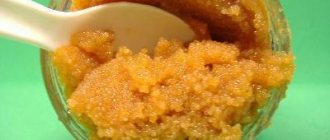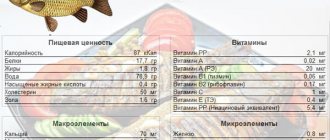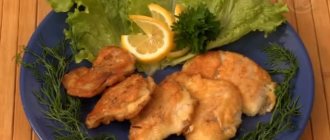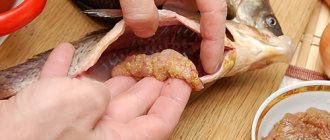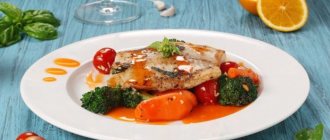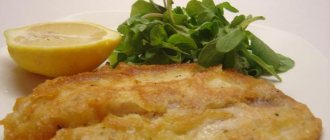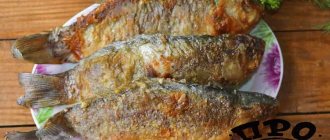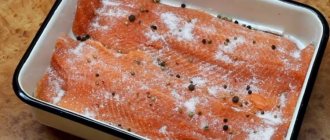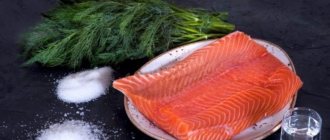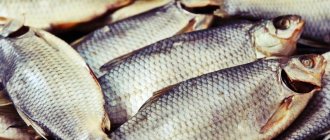- Marine
- River
- Red
- White
- Small
- No bones
- For steaks
- Fillet for frying
- Preparing the fish
- Frying rules
Salmon, trout, sea bass
and
dorado
are the most popular fish for frying and the best in terms of price and quality. Salmon is most often found on the menu of cafes and restaurants; large stores sell ready-made steaks and fillets, so we can safely say that salmon and other salmon are the best fish for frying in a pan, despite the relatively high price.
If you choose from the middle price segment, then you should pay attention to
- flounder,
- cod,
- red mullet
They are easy to make and fit into many homemade recipes.
Of the cheap options, they are most often used for frying in a frying pan.
- pollock,
- pink salmon,
- chum salmon
But they have dense and dry flesh that requires preliminary preparation.
Frying cod in a pan
Before cooking, you should figure out which fish to fry whole, and which is better to cut into steaks or fillets.
- For a homemade lunch, you can fry it whole or cut it into large pieces. Char
or
pike
are suitable for this .
If you are planning a festive feast or an original recipe, then it is better to buy a clean fillet or fillet with skin of salmon or pike perch
or
cod
.
Be sure to pay attention to the flesh of the fish. Fish that is too dry and dense requires special preparation and you need to know how to cook it correctly. If the fish is fatty, then it is much easier, although sometimes it has a specific smell, but it will definitely not be dry.
River
Pike perch, pike
and
brook trout
is the best river fish to fry. Unlike sea fish, river fish is often used for boiling or baking. The fact is that most river varieties require a long cooking time, so it is more rational to use them for fish soup or bake them in the oven.
Pike fish
Pike perch and pike are easier to fillet. In terms of taste, they are closer to marine species. River fish requires more careful preparation and longer heat treatment; small bones are more common in it.
Herring
Do you think that you will never bake this fish with a crust in the oven? You just need to know some secrets. Herring, especially Don herring, freshwater, cooks perfectly. With this method of cooking, all its numerous small seeds dissolve. The fish must be gutted and washed.
- Let's make several longitudinal cuts on the sides of the carcass.
- Rub it on all sides with salt and spices.
- Be sure to sprinkle with lemon juice or table vinegar.
- Let's marinate for at least a quarter of an hour.
- Lemon juice (or vinegar) will soften the tissues and nourish the fish fillet with moisture, thanks to which the herring will not dry out in the oven.
- Place the carcasses in a form greased with vegetable oil. It is desirable that there be as little free space as possible.
- Herring can also be greased with a silicone brush with vegetable oil or sour cream, but only with a very thin layer.
- Bake until crispy.
Red
There are many types of red fish and they are easily confused with each other. The best red fish for frying is salmon
and
trout
.
Coho salmon, sockeye salmon
and
chinook salmon
occupy second place in the ranking.
Pink salmon
, depending on the quality, is also suitable for frying, but it is still better to bake it with vegetables or sauce.
The basic rule for all red fish is that they can be slightly undercooked, this will make them juicier, just be sure to buy the fish from reliable suppliers.
What type of fish do you need?
Remember that when frying, some of the benefits of the product are lost!
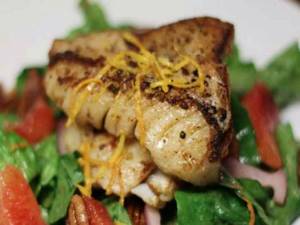
To preserve most of the nutrients, the fish is rolled in flour or semolina. During frying, a crust forms on the pulp and it is this that prevents the release of vitamins, and also adds an appetizing appearance to the dish.
To fry fish in a frying pan, decide what type of fish you need? River or sea?
A little advice:
The best river species for frying are perch, crucian carp, pike perch, catfish, etc. Remember, sea fish are less bony. It is worth choosing red fish, pollock, flounder, hake, or cod.
White
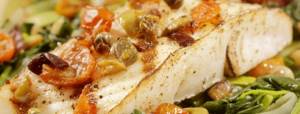
Fried pike perch
Formally, all fish except red fish can be classified as white fish. The varieties differ greatly from each other in fat content and pulp density. Dry and dense pollock is not at all like the most tender, melt-in-your-mouth halibut.
The most suitable white fish for frying is
- zander,
- cod,
- sea bass,
- dorado
Suitable Products
Dorado wild yellowtail
1850 rub. for 1 Kg. (retail)
Packaging: from 0.4 kg to 1 kg
Order
These types are suitable for many recipes; dishes with them are difficult to spoil. When preparing, consider the characteristics of each type. Sometimes a special breading is needed to prevent sticking to the pan.
No bones
If we talk about fish without bones at all, then these are sturgeon breeds
. Their main disadvantage is their high price. It's best to focus on proper butchering because many species have bones that are easily removed. Let's immediately exclude the small river fish, because it contains a lot of small bones that are impossible to remove.
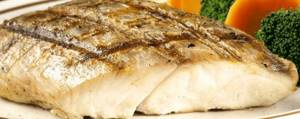
Sturgeon cooked in a frying pan
The easiest way to get boneless fish for frying is to choose a good supplier of clean fillets and additionally check each piece before cooking. Just run your finger down the middle of the fillet in both directions; if there is any bone left somewhere, you will feel it.
Video material
So we figured out what kind of fish is best to fry in a frying pan, how to do it correctly so that it turns out tasty and healthy. Follow the recipes from this article and see how interesting it is to diversify your usual diet, giving your body only useful substances.
For steaks
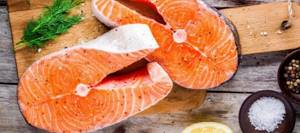
Salmon steak
Steak is conventionally called any large piece of fish. The main types for frying steaks are salmon
and
trout
, sliced crosswise.
Large cuts of tuna
are also sometimes called steak.
Large fish is used for steaks; the average size of a steak is slightly smaller than the palm of your hand.
Some restaurateurs insist that only cuts of beef can be called steak, so as not to confuse guests. Although in reality, on the menu of many establishments you can find steaks from any meat and fish.
Fillet for frying
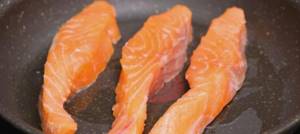
Trout fillet
Theoretically, any large to medium-sized variety of fish can be filleted for frying. The most commonly used fillets are salmon, trout, pike perch, and pike.
and
cod
.
These are versatile options that can be fried in a variety of ways, so they appear in many recipes.
How to cook properly
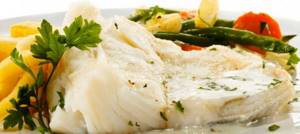
Boiled fish
The main rule is not to cook for too long. Most types of sea fish can be eaten raw, so there is no point in overcooking them. This is especially true for chilled fish of noble breeds. To preserve maximum taste and nutrients, a few minutes at a temperature of 90-100 degrees is enough for small portioned pieces.
Cooking methods
Cooking in a professional environment means:
- Poaching in a small amount of broth or broth.
- Boiling.
- Steaming.
Proper sturgeon broth
Poaching is the most rational and effective way. The fish is filled halfway with hot broth and cooked for a few minutes with spicy vegetables and herbs. The finished dish turns out tender and juicy. From the broth you can make a delicious sauce based on wine and butter.
Boiling in broth is used for large pieces or a whole carcass. Most often, stuffed pike and pike perch are prepared this way. If there is no broth, you can boil the fish in salted water with vegetables and spices. In the future, it will be useful for making soup or sauce.
Steaming is the most popular option for dietary nutrition, as it retains maximum nutrients. You can use a double boiler or place a colander of fish in a pan of boiling water. Steam is less aggressive on the meat, so it cooks a little longer.
Ingredient Selection
The following ingredients are used for boiling:
- Fragrant vegetables: onions, carrots, celery, parsley root and parsnip.
- Herbs and spices: black and white pepper, bay leaf, thyme, lemon zest.
- Greens: parsley and dill, less often celery greens and tarragon.
- Original additives: white wine, cucumber pickle, lemon juice, milk.
Flavorful vegetables are used in different ways. For broth, you can cut them into large pieces and lightly bake them in a dry frying pan. In this case, the vegetables are thrown away after cooking. To poach fish in the broth, carrots and celery are cut into thin strips or grated and placed on the bottom of the pan, and the fillet on top. This prevents the pieces from coming into direct contact with the bottom of the pan or saucepan.
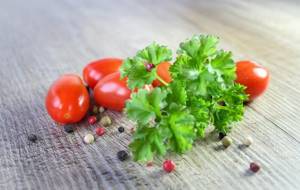
Herbs and spices for cooking fish
Among the herbs and spices, it is worth noting white pepper
.
It goes well with fish, but should be added carefully. Thyme
is often used in Mediterranean recipes in combination with parsley and bay leaves.
Dill and parsley
– universal greens for cooking.
Small leaves can be used for decoration or sauce, and the stems can be added when cooking broth. Tarragon
and
celery
have a special flavor, so they need to be added carefully.
White wine is used for poaching and further preparation of the sauce. This is a classic French cuisine technique. The wine is added in advance so that the alcohol has time to evaporate. Most recipes use dry wine or champagne.
Cooking tips
An ideal option for home cooking is poaching the fillet in a fragrant broth. This method is simple and straightforward, it saves time because it eliminates cutting and preparing the broth. You can take fillets of pike perch, pike, salmon
or
trout
, cut into portions, lightly salt. Cut the onion and carrots into thin strips, place on the bottom of a saucepan or frying pan, add sprigs of herbs, and fish on top. Pour boiling water over and simmer until tender for 10-15 minutes, covering with a lid.
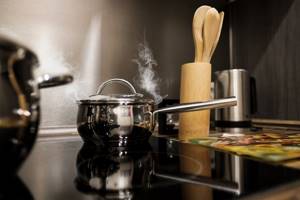
Boiling fish
If a whole carcass is used, it must be cut into fillets. Cook broth from the bones with the addition of vegetables, herbs and spices. Place portions into the boiling broth and cook until tender. Cooking time is from 5 to 15 minutes for chilled sea fish. River water is cooked longer, about 15-25 minutes.
Boiled fish does not have such a strong taste as fried or baked fish, so it is recommended to add sauce when serving. If you don’t have time to prepare it, you can pour broth or melted butter over the finished pieces.
Preparing the fish
Smaller fish, such as smelt or capelin, require less preparation. It is allowed to fry it without gutting, although this gives a specific taste, especially to capelin. If possible, it is better to get rid of the insides. No need to marinate, just add salt and pepper.
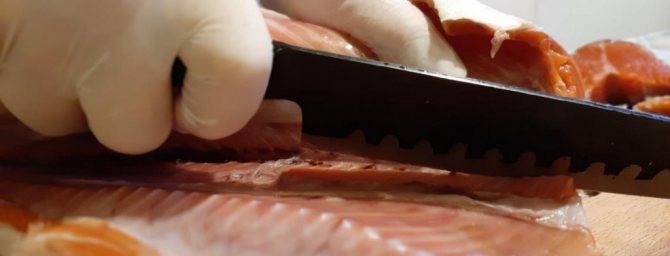
Cutting fish before frying
Fish with small scales, such as river trout or char, do not need to be scaled; just remove the insides and rinse with water. Marinate as desired, depending on the recipe, but you can get by with salt and pepper.
Large species must be cleaned of scales and entrails, thoroughly washed and cut into steaks or fillets. In some cases, they marinate in advance to make the flesh a little firmer, making it easier to fry.

Fish does not require long-term marinating, but it is not prohibited. The main thing is that the marinade is not aggressive.
Japanese chef Nobu marinates his signature cod for 24 hours in a mixture of spices, soy sauce and mirin, the result surprises many.
Small frying fish with name and brief description
Small white fish in vegetable oil in a frying pan tastes best, especially since it will take little time to cook. Another plus is the low cost of small species, so you can save your family budget.
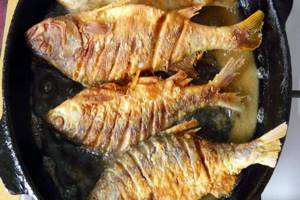
The most popular miniature river inhabitants are:
- perch. It is found in fresh waters and is small in size. A distinctive feature is spiny fins and dense small scales. Average weight varies from 150 to 300 g, does not grow larger than 2 kg;
- ruff. An adult reaches no more than 20 cm in length. It lives in fresh water, where there are no discharges. The fins have spines that protect them from predators;
- goby. Found in the Azov and Black Seas, more than 20 species are currently known. The head is large, and the body is 15-20 cm. They are caught mainly in the summer, and in cooking they are used not only for frying, but also for fish soup, and also dried;
- silver bream It belongs to the category of carp, and is found throughout Russia, so it is not difficult to catch it. Sometimes it is confused with bream, but the silver bream has large eyes and is also miniature in size - no more than 500 g. It is well suited for frying and drying;
- roach. It is also classified as a cyprinid. the size of an adult does not exceed 300 g. The body is covered with silvery scales, which change color to brown closer to the ridge. The fins are orange. It is found in all fresh rivers of Russia and is famous for its delicious meat, especially if the roach is fried;
- gudgeon. Surely everyone has caught this small river inhabitant while fishing. Its size is small, only 10-20 cm. The head of the gudgeon is large compared to the rest of the body, and the color is dark to blend with the bottom. Leads a bottom-dwelling lifestyle, but tastes good, especially fried and dried;
- chop. The predator is found in fresh water and belongs to the perch family. There are spines on the gills that protect against enemies. It is not easy to catch him because the chop is careful. But it tastes incomparable.
Even a small fish needs to be properly prepared for frying: cleaned of scales, cut off the fins and gutted. Only then will you be able to fully enjoy the tender meat.
On a note!
Miniature carcasses can be rolled in semolina and then fried in a frying pan hot with oil until golden and delicious.
